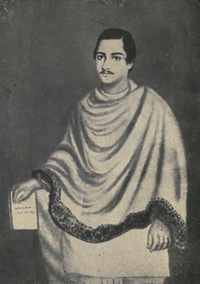Kaliprasanna Singha
| Kaliprasanna Singha | |
|---|---|

Kaliprasanna Singha
|
|
| Born |
23 February 1840 Kolkata, Bengal, British India |
| Died | 24 July 1870 (aged 29) Kolkata, Bengal, British India |
| Nationality | Indian |
| Occupation | Litterateur |
| Parent(s) | Nandalal Singha |
Kaliprasanna Singha (23 February 1841{?} – 24 July 1870) was a Bengali authors, playwright, and philanthropist. His most famous work was the translation of the ancient Hindu epic Mahabharata into Bengali. Singha's book Hutom Pyanchar Naksha, a compilation of satirical social sketches, is another noted work that is noted for reflecting Bengalee urban society of the time. He is also remembered as a philanthropist who helped several people and movements in distress.
Though the exact date of Kaliprasanna Singha's birth is debatable, on 24 February 1840, the Calcutta Courier published a news that celebrations were made on 23 February 1840 on the occasion of the birth of the son of Nandalal Singha of Jorasanko. The confusion about his year of birth is that initially researchers found his death announcement where it was said that he died at the age of 29 in 1870. However, if the news published in Calcutta Courier, found at a later date, is taken into account, his date of birth would be somewhere near 23 February 1840.
Kaliprasanna was born into the renowned "Singha" family of Jorasanko in North Kolkata. His father, Nandalal Singha, was the son of Jayo Krishno Singha (or Jay Krishna Singha), who was one of the directors of Hindu College, Kolkata. Nandlal died when Kaliprasanna was only six years old. Babu Hara Chandra Ghosh, a judge of the lower court, was appointed as the guardian after his father's death.
In his short span of life (1841–1870), Kaliprasanna was a man of unbelievable versatile qualities. It is said that he had a power to recollect anything that he would see or hear even once, and that also from a very early age. The foundation of the Vidyotsahini sabha by him at the age of only 14 bears a testimony to the abilities of this child prodigy. Ishwarchandra Vidyasagar was astonished to see how this young boy could mingle with so many elderly associates and lead them towards recreational pursuits such as organisation of the theatres. Hutom Pyachar Noksa is his immortal creation in which portrayed the picture of the 19th-century babudom in Kolkata. Sunil Gangopadhyay, in his epoch making novel Sei Somoy (Those Days), recreated the same period with Kaliprasanna as the symbolic character, his name in the novel being Nabinkumar.
Kaliprasanna married the daughter of Loknath Basu of Bagbazar in 1854, but she died in a few years. Sometime later, Kaliprasanna married Sharatkumari, daughter of Chandranath Basu of Hatibagan, and sister of Prabhas Chandra Basu. Chandranath Basu's wife (presumably Sharatkumari's mother) was a granddaughter of Raja Prasanna Narayan Deb.
Kaliprasanna was admitted to Hindu College, currently known as Presidency University. In 1857 he left college. He continued his education in English, Bengali and Sanskrit at home. He enhanced his English knowledge under the guidance of a European teacher Mr.Kirkpatrick. He had contribution in different fields as an author, editor, a publisher, a philanthropist, a social worker, and a great patron of art, literature and culture.
...
Wikipedia
